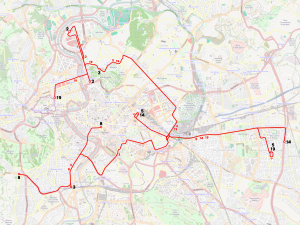
The Rome Metro is a rapid transit system that operates in Rome, Italy. It started operation in 1955, making it the oldest in the country.

Termini is an underground station of the Rome Metro. The station was inaugurated on 10 February 1955 as a station on Line B, and later became an interchange with Line A. The station is found in Piazza dei Cinquecento, under the Termini rail terminal. Together, the two stations form the main public transport hub in the city.

Flaminio–Piazza del Popolo is an underground station on Line A of the Rome Metro, inaugurated in 1980. The station is situated on the large Piazzale Flaminio, in the Flaminio quarter outside the Aurelian Walls, next to Piazza del Popolo, and is near the Campus Martius.

Line A of the Rome Metro runs across the city from the north-west terminus of Battistini to the south-east terminus at Anagnina. It intersects with Line B at Termini and with Line C at San Giovanni. The line is marked orange on metro maps.

Piazzale Flaminio is a square in Rome (Italy) and the starting point of the Via Flaminia.
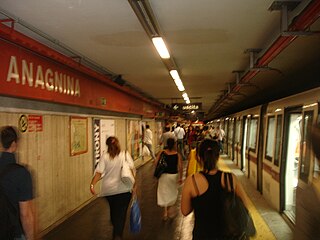
Anagnina is a station of Line A of the Rome Metro. It is located at the junction between Via Tuscolana and Via Anagnina, close to the depot of Osteria del Curato. The station is at an altitude of 53 metres (174 ft) above sea level.

Roma Ostiense is a railway station in Piazza dei Partigiani serving the Ostiense district of Rome, Italy, a short distance from the Porta San Paolo. It is run by the Rete Ferroviaria Italiana arm of the Ferrovie dello Stato Italiane group and the commuter rail lines FL1, FL3, and FL5 run through the station. It is linked with the Piramide Metro B station and the Roma Porta San Paolo station on the Rome-Lido railway line.

Rome is a tourist destination of archaeological and artistic significance. Among the most significant resources are museums – —aqueducts, fountains, churches, palaces, historical buildings, the monuments and ruins of the Roman Forum, and the Catacombs. Rome is the 2nd most visited city in the EU, after Paris, and receives an average of 7–10 million tourists a year, which sometimes doubles on holy years. The Colosseum and the Vatican Museums are the 39th and 37th (respectively) most visited places in the world, according to a recent study. In 2005 the city registered 19.5 million of global visitors, up of 22.1% from 2001. In 2006, Rome was visited by 6.03 million international tourists, reaching 8th place in the ranking of the world's 150 most visited cities. The city has also been nominated 2007's fourth most desirable city to visit in the world, according to lifestyle magazine Travel + Leisure, after Florence, Buenos Aires and Bangkok. Rome is the city with the most monuments in the world.
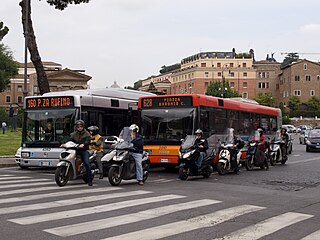
Rome has an extensive internal transport system and is one of the most important road, rail and air hubs in Italy.

Municipio I is an administrative subdivision of the municipality of Rome, encompassing the centre of the city.

The Rome trolleybus system forms part of the public transport network of the city and comune of Rome, Italy. In operation since 2005, the current system comprises three routes.
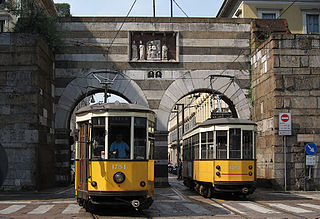
The Milan tramway network is part of the public transport network of Milan, Italy, operated by Azienda Trasporti Milanesi (ATM).

The Modena trolleybus system forms part of the public transport network of the city and comune of Modena, in the region of Emilia-Romagna, northern Italy.

Alfa Romeo 140A is an Italian bus model produced by Alfa Romeo from 1950 to 1958. The bus was produced for Azienda Trasporti Milanesi (ATM) in Milan, Italy.
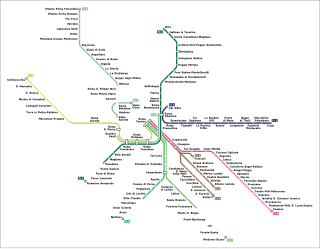
The FL5 is a regional rail route. It forms part of the network of the Lazio regional railways, which is operated by Trenitalia, and converges on the city of Rome, Italy.

The FL4 is a regional rail route. It forms part of the network of the Lazio regional railways, which is operated by Trenitalia, and converges on the city of Rome, Italy.
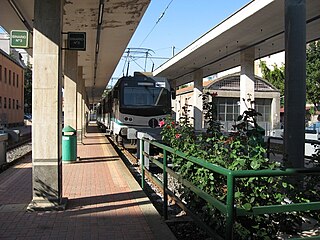
The Rome–Civita Castellana–Viterbo railway is a regional railway line connecting Rome, Italy, with Viterbo, capital city of the Province of Viterbo. The 102 km (63 mi) long line, also known in Rome as the Roma Nord line, after its former concessionaire, is part of Rome's metropolitan and regional railway network.

ATAC S.p.A. is an Italian publicly owned company running most of the local public transportation services, paid parking and incentive parking lots in Rome. More specifically, the company handles, on behalf of Roma Capitale Authority, the entire tramway, trolleybus network and metro lines, as well as most of the bus lines in the city. It also operates, on behalf of the Administrative Region of Lazio, three railways: Roma-Civita Castellana-Viterbo, Roma-Giardinetti and Roma-Lido. ATAC S.p.A., with its 2,200-kilometer-wide public transport network, its over 8,500 busses and 70,000 parking stalls, is currently one of the biggest public transportation companies in Europe and the largest in Italy.

Flaminio is the 1st quartiere of the Italian capital Rome. Identified by the initials Q. I, it belongs to the Municipio II and has 13,018 inhabitants and an area of 1.1877 km². The name is derived from the Via Flaminia.

The Piazzale Flaminio railway station is a railway station in Rome (Italy) and the terminus of the Rome–Civitacastellana–Viterbo railway, managed by ATAC.



